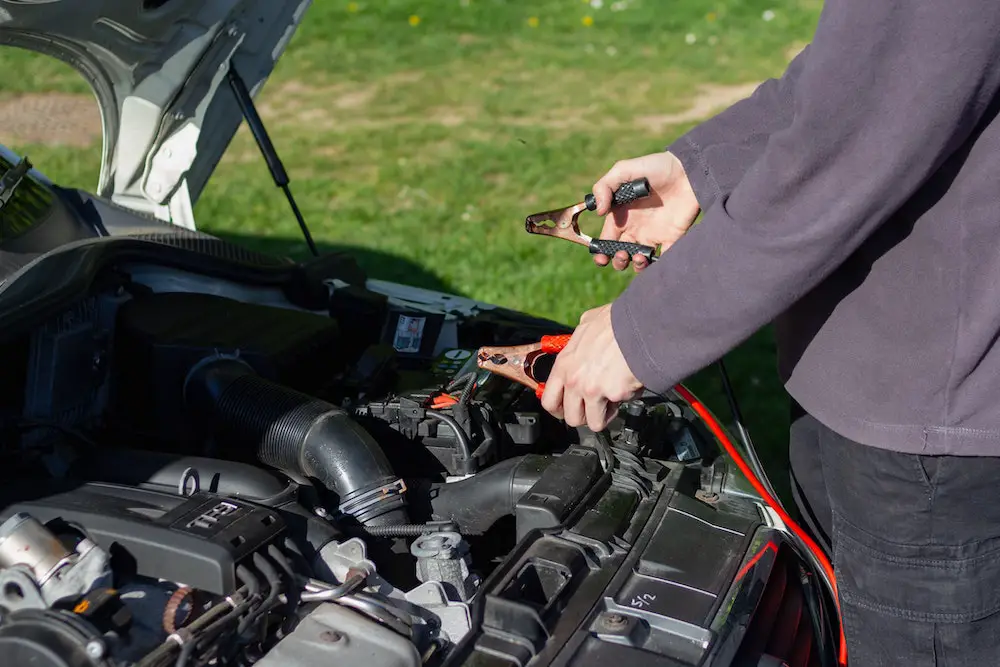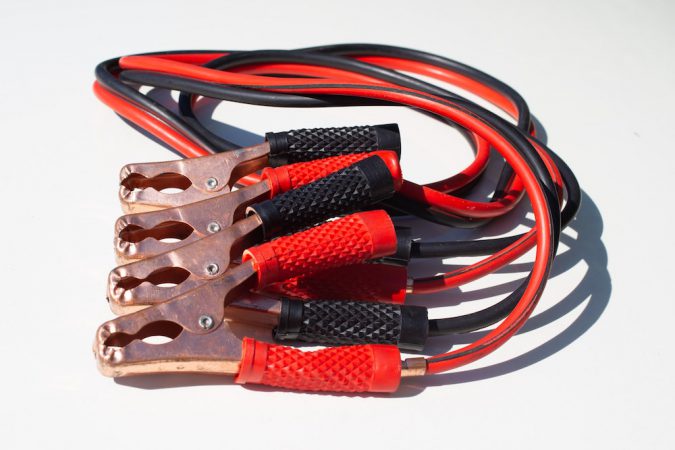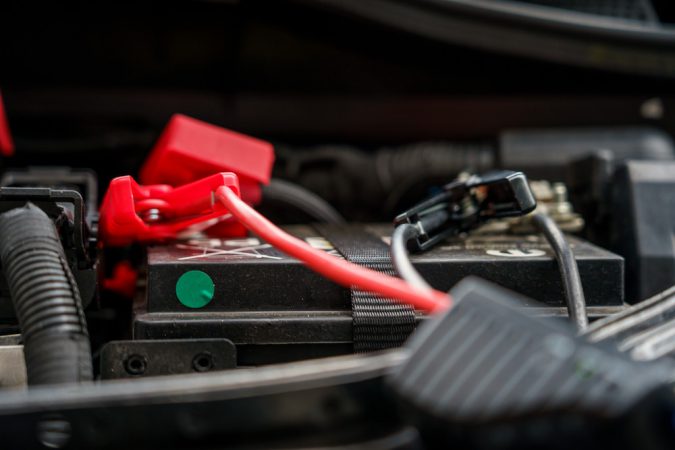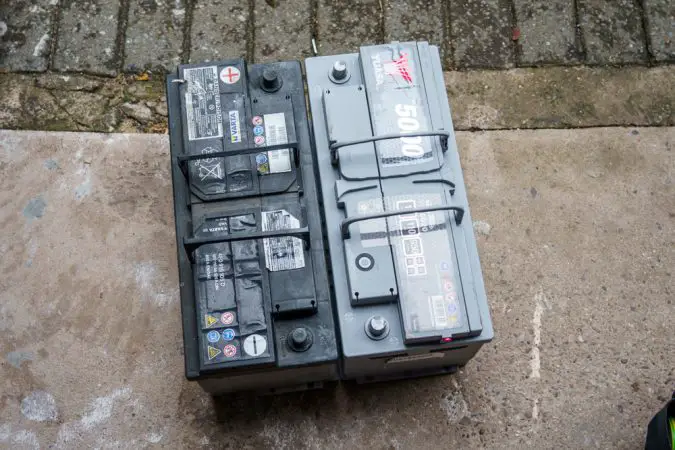Are you on the market for new jumper cables and you probably want to get ones that will serve you for a long time? You are probably asking yourself which is the best gauge for jumper cables? That’s since the gauge is one of the most important tools, because the lower the gauge, the thicker the cable and the more power it can transfer.
- What Are Jumper Cables?
- What Is Gauge?
- Best Gauge
- How To Use
- Consequences Of Error
- Alternative Ways
- Conclusion
Jumper cables are a necessity in your vehicle and they should be one of the essentials in your trunk along with the triangle and the first aid kit. The occasions that you will need them are rare. But they can save your skin in some tight situations.
Imagine that you need to go to work in the morning and your battery is empty. This situation can be extremely tricky because nobody likes people who are late. You will probably get a deduction from your pay for being late or something else that will affect you.
Or imagine a situation that you need to go on a date. You just can’t find a way to start your car. Your date is going to be extremely mad at you because you couldn’t manage to come. And there will probably be no second chance. That’s why jumper cables are one of the essentials that everyone should have in their car. Without them, life would be much more difficult.
In this article, we are going to discuss everything you need to know when it comes to jumper cables and empty battery situations. We will discuss what are the jumper cables and what is the best gauge for jumper cables. We will also list some alternative ways that you can try to start your car. So, without further ado, let’s dive into the article.
What Are Jumper Cables?
Jumper cables are the cables that help you start your car. But how do these jumper cables work? How jumper cables work is pretty simple. They transfer the electricity from one battery to another battery.
Hypothetically, one of the batteries will be in your car if your car cannot start. And the other battery will be in another vehicle. A friend let’s say that decided to help you out starting your car.
He comes to your location and you connect the positive terminal to your car to the positive terminal from your friend’s battery. Then, the negative terminal from your car to the negative terminal to his car’s battery.
The jumper cables have clamps that make this possible. The wires are very straightforward to use and you only need to use your logic. You just press the clamp with your hand and the clamp opens. Then you attach the clamp to the terminal. There are four clamps – two per car. One positive and one negative.
The important thing is not to mess up the cables and connect the positive with the negative. With this, you can damage one of the batteries. So, be focused and don’t rush while doing this work if you don’t want to mess up.
Then, you can crank your car and when you crank it, your battery will pull some juice from the other battery and help it start. Understanding how these jumper cables are very easy and intuitive.
If you have some trouble with learning how to do it by yourself, you can always look online for tutorials. YouTube is full of them and they are pretty in-depth. We’re also going to share with you a DIY tutorial on how you can do this procedure at home later in the article.
What Is Jumper Cable Gauge?
Before you try to learn what is the best gauge for jumper cables, you first need to learn what is the jumper cable gauge in the first place. Gauge is measured from 1 to 12, the bigger the number, the lower amount of electricity that this cable can transfer.
You need to learn the gauge because when you are out there shopping for jumper cables for the first time, you don’t know where to look. The first big heavy-duty jumper cables will probably look attractive to you. But looks can be deceiving. The biggest isn’t always the best.
So, if you are looking at a 10-gauge cable, this means that this cable won’t cut it for you. You probably think that bigger is better. In this case, it is not. A higher gauge number is not better than a lower number. The lower number the better the cable. So, the best thing for you is to look for cables that have a lower gauge. But what is the best gauge for jumper cables? Let’s find out.
What Is The Best Gauge For Jumper Cables?
We have covered what gauge is, now let’s see which is the perfect gauge for you. Because the gauge is the most important thing when you shop for jumper cables.
If you are running a regular car, a gauge of 6 would probably be enough. This is the recommended gauge for most cars that are on the roads.
If you are running a bike, then you can use a 10-gauge cable. Since bikes do not draw a lot of power, a smaller size cable is probably going to be enough for your needs.
Then if you have a full-size truck, especially a diesel truck with a big battery then you should go for a 4-gauge jumper cable. This thicker cable would be perfect to jump-start some heavy machinery.
But if you have something heavier like a truck that needs a lot of juice and is powered by a couple of batteries. Or maybe a skid steer or other machinery. Going for a gauge of 1 or 2 would be up to the task and you will be able to jump-start these vehicles.
Take note that these pieces of equipment require a lot of energy, and a gauge of 6 or 4 will not work and the wires will burn. That’s why it is good to know which is the best gauge for jumper cables.
Knowing this will help you start your vehicle in no time and do your business without any delays.
Cable Length And Clamps
Cable length and clamp size are also important. The longer the cables, the more space you have to work and start the vehicle. If you have short cables, they won’t reach. That’s why I would avoid getting anything less than 12 to 16 feet.
There are cables 6 feet long that you can buy, but imagine that you need to jump-start your car and the car is in the garage. There will not be a way that you can access the car battery from the outside.
Or if the car is stuck in someplace that is almost impossible to access it from the front. This can be a frustrating thing to deal with and you should avoid getting short jumping cables because you never know where your car could end up.
Imagine the situation that would be if you cannot reach your terminals for only a few inches. That’s why getting 12 to 16 ft cables are the perfect option for you. With these cables, you will be able to start a car even if it’s in some barn or something and you will never have to worry.
There are also longer cables than this, and these could be a bit overkill for this purpose. Just make sure that they are above 12 ft and the gauge is the right gauge for your car or truck.
As we said, the best gauge for jumper cables is 4 to 6 for full-size trucks and cars and gauge 2 for big pieces of machinery or 16-wheeler trucks.
The clamps are also important. Make sure that you get cables with big bulky clamps, that are going to hold really nice. Because you need that contact.
How To Use Jumper Cables? – Best Gauge For Jumper Cables
This is a good question. We learned what is the best gauge for jumper cables and now let’s learn how you can use these jumper cables. Because if you don’t know how to use them, how you will start the car?
Although, they are very intuitive to use. Some beginners that are not into cars will panic and will end up making a mistake while performing this practice. The most important thing is not to panic and follow the directions correctly. That way, you will never make a mistake and you will start your car simple and effectively without draining the other battery. And how does this process go?
The first thing you need to do is to open up your hood and the hood from the car that you plan to jump your car from.
The next thing to do is to start the other car that you plan to drain energy from. This is necessary if you don’t want to destroy the battery of that car. This is the case because this type of cranking could drain the power from the other car and leave it without power. That’s why the car has to run when this practice is performed.
The next step involves connecting the positive cable of the jumper cables with the positive, and the negative cable to the negative. First on the car that is running and then the car that you plan to jump-start.
Then, you can crank the vehicle. Once the vehicle starts, you can remove the clamps and the battery will start charging. You don’t have to keep the clamps on the vehicle since the alternator has started powering the vehicle that was jumped. And that’s it. You remove the clamps; close the hood and you are good to go.
What Will Happen If I Connect The Positive With The Negative
Since we learned what is the best gauge for jumper cables and we also learned how you can jump your car. Now let’s see what could happen in a hypothetical situation when you unknowingly will connect the positive with the negative cable.
This mistake often occurs when you are rushing things out and you might forget where you put your clamp to. That’s why it is good to know what are the possible outcomes of this mistake that could occur to your battery if you make this mistake.
So, what could happen? There are two outcomes and these are damage to the batteries and damage to the cables. Also, you can damage the electrical components in your vehicle due to overpowering the battery. Let’s discuss them one by one.
Damage To The Jumper Cables
One probability in a hypothetical situation like this is that there will be damage to the jumper cables. They are not designed to carry the same power since one is for positive and the other is for negative.
If you mismatch them, there will be a great surge of energy that will burn or melt the cables and you will throw them in the trash. And this is probably the easiest way out of this. Damaged cables only cost $50 let’s say. No big deal. But what about the other damage to the batteries?
Damage To The Batteries
This surge of electrical power where is not needed will lead to damage of the cells of the battery that has the negative cable. This reverse charging will fry some of the cells that are in the battery. And the heat will develop inside of the battery.
This heat can create hydrogen gas that could even crack the battery casing and cause the battery to leak out. This can not only ruin your battery but also it’s going to be environmentally dangerous. The cheapest way to go around this will be by getting a new battery for around $150. But the worst-case scenario would be damaging to your system.
Electronic Component Damage
Mismatching the positive and negative cables will also probably going to cause some electric defects in your car as well. Cars are packed with technology and sensors these days. And this mistake can cause them to malfunction. Or in the worst case, they could burn and you might end up paying thousands of dollars for repairs.
Also, one of the most common consequences of this action is a burnt alternator. Remember that the alternator is the one that is generating power in the vehicle. A new alternator is going to cost you more than $300 to replace.
That’s why you should never mismatch the positive and negative cables. Sometimes, the damage can be simple and reversible. But in some instances, it can completely obliterate the systems in your car and you will end up paying thousands of dollars on repairs. And you don’t want that to be honest.
Alternative Ways To Start Your Car
We have covered these important topics like the best gauge for jumper cables and we shared some input on how correctly to start your car. Now let’s see some alternative ways that you could jump your car. There are a ton of other possibilities out there and you can try something else if you are tired of using jumper cables to jump-start your car. But which are these other ways? Let’s find out.
Push The Car To Start
A good old method if you have a manual car is to push the car to start. How this works is pretty straightforward. Call a friend to give you a little push or if you are uphill use this as an advantage to start your car.
To start the operation, you need to put the car into first gear. But you should not release the clutch right away.
Tell someone to push your car, and as the car gains momentum, release the clutch. The car will start itself in this situation and you will drive off without getting another car and jumper cables. A simple method that always works. If it doesn’t work on the first try, you can repeat the process again until the car starts. And eventually, it will start, you need to be persistent with it.
Get a Jump Starter
One of the options is to get a jump starter. These jump starters are modern portable batteries with two terminals. A positive and a negative. It is the same as you jump your car from another car basically.
You connect the positive to the positive and the negative to the negative terminal and you start your car. Simple as that.
The downside of these jump starters is their price. You can expect to pay a few hundred dollars to get one. So, if you don’t use it quite often to jump cars, it is expensive.
Also, the batteries that are inside of the jump starter usually start to lose charge over time. And also their durability. So, you will have to recharge it quite often when it gets older.
Borrow A Battery From Another Car
And the last way to start a car is by getting another battery. It cannot be simpler than this. If you have a battery that is sitting around or you have a battery in some of the vehicles that you don’t use, you can try using this battery to start your vehicle.
This is the simplest method you can try and it works. This battery could be from lower power. But for one or two starts, it will do the trick quite well. Remember that you need to get a new battery or connect your old battery to recharge while the car is running.
How To Test A Battery?
This is a good question. It is important to know how to test a battery. Knowing this, you will never be left stranded in your car. For this job, you will need a multimeter tool.
A multimeter is a tool that can measure voltage and resistance. For this purpose, you will only need to know the voltage.
Turn on the multimeter and connect it to your battery. One probe to the negative and one to the positive. Make sure that you get them right. The black is usually negative while the red is positive.
Any result below 12V is a bad result. A good battery that has 6 cells should have at least 13 to 13.5V of power. If the power is below the 12V mark. Then you know that you are having a weak battery.
This can be caused by either your alternator is bad. Or simply the battery is old and doesn’t hold the power. If the battery is old, you should replace it. Or if the battery is new, then you need to learn if you have a parasitic loss.
Why Is My Battery Getting Empty?
As we mentioned above, your battery could be losing power. And this power loss can be caused by parasitic loss. The parasitic loss problem is when something is draining your battery much quicker than expected. You can learn more in our guide on what drains a car battery.
But what could this be? The most probable option is that you have a short in your electrical system. This is a clear example of why there is parasitic loss. This means that some component is draining your battery.
In this case, the best option for you is to visit a car electrician. Car electricians are specialists for this type of work and they will find the problems extremely quickly. Since they know how the electrical systems work.
Also, if you installed some aftermarket components like a surround system or an aftermarket radio, make sure that you connected everything well. Sometimes, when components are not connected correctly, they can draw power from the battery and cause you to look for the best gauge for jumper cables.
Jumper Cable Facts:
- Jumper cables and booster cables are interchangeable terms.
- The wire gauge of jumper cables refers to how thick the wires are.
- A 6-gauge or 4-gauge set of cables is sufficient for most vehicles.
- Thicker insulation on jumper cables helps prevent dangerous arcs and protects the wires from cold weather.
- Longer jumper cables (at least 20 feet) provide greater flexibility in positioning the vehicles.
- Jumper cables should have heavy-duty clamps with a strong grip, thick rubber insulation, and solid copper or aluminum conductors.
- The amperage rating of jumper cables should be higher for larger engines, typically 400 amps for standard cars and 800-1000 amps for trucks and SUVs.
- Inexpensive jumper cables are more likely to fail, and damaged cables should be replaced.
- Copper-plated cables may be less effective when the plating wears away.
- Jumper cables should be stored coiled in a loop to prevent damage to the wires.
Conclusion – Best Gauge For Jumper Cables
In this article, we have learned a lot when it comes to jumper cables. We learned what jumper cables are and we learned how to use them.
We also learned what is the best gauge for jumper cables. This is important to know for your applications. Since not all the jumper cables will work on any car battery.
Then we have covered other important topics like the possible damage if you connect your jumper cables the wrong way. We learned that the cables and the batteries could go bad and even some electrical components can fail.
Lastly, we learned which are the alternatives to start off your car. It is useful to know what are the other options on the table.




